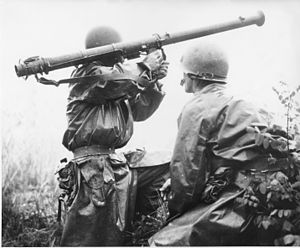Task Force Smith
| Battle of Osan | |||||||
|---|---|---|---|---|---|---|---|
| Part of the Korean War | |||||||
 An American soldier (Robert L. Witzig) with a 2.36-inch bazooka prepares to take aim at a North Korean tank during the Battle of Pyongtaek which took place after the Battle of Osan. On his right is Kenneth R. Shadrick, who would later be reported as the first American killed in the Korean War. |
|||||||
|
|||||||
| Belligerents | |||||||
| Commanders and leaders | |||||||
|
|
||||||
| Units involved | |||||||
|
|||||||
| Strength | |||||||
| 540 infantry and support |
|
||||||
| Casualties and losses | |||||||
|
|
||||||
The Battle of Osan (Korean: 오산 전투) was the first engagement between United States and North Korean forces during the Korean War, on July 5, 1950. Task Force Smith, a U.S. task force of 400 infantry supported by an artillery battery, was moved to Osan, south of the South Korean capital Seoul, and ordered to fight as a rearguard to delay advancing North Korean forces while additional U.S. troops arrived in the country to form a stronger defensive line to the south. The task force lacked both anti-tank guns and effective infantry anti-tank weapons, having been equipped with obsolescent 2.36-in. rocket launchers and a few 57 mm recoilless rifles. Aside from a limited number of HEAT shells for the unit's 105-mm howitzers, crew-served weapons capable of defeating the T-34 Soviet tank had not been distributed to U.S. Army forces in Korea.
A North Korean tank column equipped with ex-Soviet T-34/85 tanks overran the task force in the first encounter and continued its advance south. After the North Korean tank column had breached U.S. lines the Task Force opened fire on a force of some 5,000 North Korean infantry approaching its position, temporarily holding up the North Korean advance. North Korean troops eventually flanked and overwhelmed American positions and the remnants of the task force retreated in disorder.
On the night of June 25, 1950, ten divisions of the North Korean People's Army launched a full-scale invasion of the nation's neighbor to the south, the Republic of Korea. The force of 89,000 men moved in six columns, catching the Republic of Korea Armed Forces by surprise, resulting in a rout. The smaller South Korean army suffered from widespread lack of organization and equipment, and was unprepared for war. The numerically superior North Korean forces destroyed isolated resistance from the 38,000 South Korean soldiers on the front before it began moving steadily south. Most of South Korea's forces retreated in the face of the invasion. The North Koreans had captured South Korea's capital of Seoul by June 28, forcing the government and its shattered army to retreat further south.
...
Wikipedia
